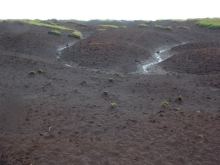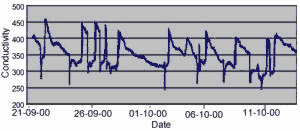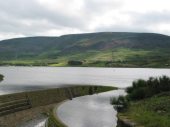Hydrology of Blanket Peat

One of the major features that makes peat so unique is the contribution that water makes to its characteristics:
- Water supply to the peat is abundant.
- Peat is 80-90% water.
- The bottom catotelm layer of blanket peat is permanently saturated.
- Saturation leads to peat shedding its excess water by overland flow and subsurface flow into drainage streams
- High water tables exist throughout most of the year so the blanket peat is saturated and has limited infiltration capacity.
- The water is of low nutrient content as nutrients are supplied by rainfall alone.
Sediment Yields from Blanket Peat Catchments
- The main source of eroded peat sediment (which causes many of the problems discussed in the previous page) is overland flow. The collapse of channel banks in steep sided gullies can also be important.
- Sediment yields can reach up to 50 tonnes per km2 per year in streams within heavily eroded catchments.
- Yields of 100 tonnes per km2 per year are confined to upland and high precipitation areas.
- Maximum sediment loads occur in early winter and drop thereafter.
- This implies that the material was prepared by desiccation during the summer, and moved during the autumn & early winter storms - after which the sediment supply is depleted.
- The low density of peat means that volumetrically impacts are severe, leading to;
- Habitat loss.
- Loss of amenity.
- Water quality problems.
What streamflow data tells us

- That peat must be 'prepared' before being eroded (i.e. vegetation must be removed or the peat body damaged or disturbed in some way).
- Typically in storms on peatland streams, suspended sediment concentrations peak before peak stream flow (positive hysteresis).
- This is typical of sediment exhaustion - where all available pre-weathered material is moved in the early part of the storm so that the sediment supply is dramatically reduced.
Peat Slides
- These are associated with prolonged, heavy rainfall from summer convectional or rain on snow in winter.
- Failure of the peat mass occurs typically at the peat/ mineral interface.
- Volumes of peat movement reach up to 30,000 m3.
Methods preventing sediments reaching water supplies
To protect the water contained in the Longdendale reservoirs, preventative measures have been used throughout the catchment:
- Conduits (pipes to carry clean water away from eroded catchments).
- Check dams to block gullies and allow peat to be trapped behind them.
- Bywash channels. Used in times of high flow to stop transport of eroded peat sediments before they can reach reservoirs and divert discoloured water and sediments away from the storage areas
Infiltration in peatland
- The infiltration of water into peat depends on its moisture and degree of erosion.
- In undrained (uneroded) peat, the water table is at or near the surface.
- During drought periods, the water table falls, saturation then exceeds overland flow, solutes increase and sub-surface stormflow (i.e. throughflow) increases
- In eroded or drained peat the water table is lower. During droughts there is a decrease in saturation-excess flow, the peat dries out and is thus susceptible to further erosion by throughflow through the dry (and therefore more easily eroded) peat.
- Because of the high levels of surface runoff, rainfall is transported as stormflow, resulting in FLASHY responses to rainfall events.
| Vegetation cover | Infiltration characteristics |
|---|---|
| Cotton grass moorland | Infiltration capacity easily reached - excess overland flow |
| Bilberry and crowberry | Infiltration capacity rarely reached and only in exceptional storms does overland flow occur |
Characteristics of peat streams

- Long periods with little or no flow (small amount of water, slow flowing, if at all).
- Short storm events with very high runoff, returning most precipitation almost immediately to the channel - flashy response
- No delayed flow as throughflow in peat is minimal.
- Increase in discharge during storm events is associated with a fall in solute concentrations and an immediate increase in suspended sediment concentrations.
- This is due to increased surface and near surface flow.
- Water has a very limited residence (contact) time with the peat. It has little time to gain a soluble load as it runs across the peat.
- The rain also effectively 'dilutes' the solute concentration already in the stream.
- The fast moving surface water favours the acquisition of a large sediment load.
Solute origin - Where do solutes come from?
1. Atmospheric sources.
- Rainwater is the dominant solute carrier adding to peat catchments during precipitation events.
- Solutes come from sea spray (sodium and chlorine), dusts from the earth's surface (smaller minerals such as Fe, Cu and Al) and pollutants such as nitrates, sulphates, ammonia and heavy metals.
2. Windblown dust, pollen and other airborne materials.
3. Dry deposition of gases e.g. NOx' s and SO2.
